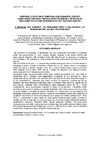Identificador persistente para citar o vincular este elemento:
https://accedacris.ulpgc.es/handle/10553/11240
| Title: | Temporal evolution of emerging contaminants, priority substances and heavy metals most frequently detected in reclaimed water and grounwater in a volcanic aquifer | Authors: | Estévez, Esmeralda Cabrera, M.C. Fernández-Vera, Juan Ramón Molina-Díaz, Antonio Robles-Molina, José Palacios-Díaz, M.P. |
UNESCO Clasification: | 250804 Aguas subterráneas | Keywords: | Emerging contaminants Priority substances Heavy metals Reclaimed water Groundwater, et al |
Issue Date: | 2013 | Abstract: | The presence of emerging contaminants has been previously described in reclaimed water and groundwater of Gran Canaria (Spain). Despite of the environmental risk associated to irrigation with reclaimed water (R), this practice is necessary considering sustainability of the hydrological cycle in semiarid zones, especially regarding agricultural activity. The aim of this study was: i) to analyse the evolution during two years of contaminants of emerging concern, priority substances (2008/105/EC) and heavy metals in reclaimed water (R) and in a volcanic aquifer in the NE of Gran Canaria where a golf course has been irrigated with R since 1976 and ii) to relate this presence with physicochemical water properties and hydrogeological media. Reclaimed water and groundwater (GW) were monitoring quarterly from July 2009 to September 2011. Sorption and degradation processes in soil account for more compounds being detected in R. Diazinon and chlorfenvinphos were detected always in R and terbuthylazine, terbutryn and diuron at 90% of frequency. Considering all the samples, the most frequent compounds were chlorpyrifos ethyl, fluorene, phenanthrene and pyrene. Although their concentrations were frequently below 50 ngL-1, some contaminants, were occasionally detected at higher concentrations. Chlorpyrifos ethyl and diuron are priority substances detected frequently and at high concentrations so they must be included in monitoring studies. Geology and location seem to be related to the emerging compounds presence due to occasional contamination events (not related to R irrigation) and therefore not to an existence of a dangerous diffuse contamination level. Thus, it is preferable to select wells with less stable chemical water quality, in order to monitor the risk of emerging compounds presence. Considering the relationship between contaminant presence, chemical water quality, seasonal variation, hydrogeological characteristics and wells location we can conclude that chlorpyrifos ethyl and diuron were the most dangerous priority substances in terms of GW quality so they must be included in all of the monitoring studies, at least in Canary Islands. | URI: | https://accedacris.ulpgc.es/handle/10553/11240 | Source: | Proceedings of the 13th International Conference on Environmental Science & Technology, Athens, Greece, 5-7 September 2013, T.D. Lekkas, editor, University of the Aegean, Global NEST, 978-960-7475-51-0, 13 p. | Rights: | by-nc-nd |
| Appears in Collections: | Actas de congresos |
Page view(s)
63
checked on Jan 27, 2024
Download(s)
77
checked on Jan 27, 2024
Google ScholarTM
Check
Share
Export metadata
Items in accedaCRIS are protected by copyright, with all rights reserved, unless otherwise indicated.
